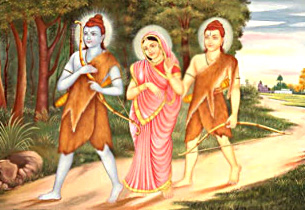

Many of its translations into vernacular languages are themselves works of great literary value including the Malayalam version of Ezhuthachan, Tamil version of Kamban, the Bengali version of Krttibas, and the Hindi version of Tulsidas. From this is clear that the Ramayana is the very essence of the Vedas.

It was Satrughna who safeguarded the places of sacred rituals like Yajnas and Yagas from the invasion of evil spirits and demons.

It is for this reason that Bharata is described as the personification of Sama Veda. While Rama was in exile, Bharata left Ayodhya and stayed in a village called Nandigrama, all the time singing the divine name of Rama for 14 long years!. This must be the reason why Sage Viswamitra took Rama and Lakshmana along with him to safeguard his Yajna. The Rig Veda and the Yajur Veda consist of Mantras which are related to Yajnas and Yagas. Thus the four Vedas became the four sons of Dasaratha. Lord Rama is the embodiment of Rig Veda, Lakshmana, the Yajur Veda, Bharata, the Sama Veda and Satrughna, the Atharva Veda. The Vedas are divided into four parts, viz., Rig Veda, Yajur Veda, Sama Veda and Atharva Veda. It is the very form of the Vedas that have come down to us from the heavens to the earth. It is said that just as the Veda Purusha (Virat Purusha) was born as Dasaratha's earthly son, the Vedas are born from Prachetasa (Valmiki) in the form of Ramayana. To reassure them, Rama banishes Sita to a hermitage, where she bears him two sons, Lava and Kusha and eventually dies by reentering the earth from which she had been born. However, when Rama is restored to his kingdom, the populace casts doubts on Sita’s chastity while a captive. In a battle, Ravana is defeated and Sita is rescued. In their search for Sita, the brothers ally themselves with a monkey king called Sugriva whose general, Hanuman finds Sita in Lanka. While there, Sita is abducted by Ravana, the demon king of Lanka. He is exiled to the forest with his wife Sita and brother Lakshmana. As advised by them, he recited the name of Lord Rama for the sins committed on others and became enlightened.Īs per the epic, Rama is deprived of the kingdom of Ayodhya to which he is heir to King Dasaratha. However, his encounter with two enlightened sages was a turning point in his life. Sage Valmiki was known before his spiritual transformation as Ratnakar and was a fierce dacoit who indiscriminately waylaid, beat up and robbed unsuspecting wayfarers. Everything in the epic is designed for harmony, which after being disrupted is at last regained. Rama and Sita set the ideal of conjugal love Rama’s relationship to his father Dasaratha is the ideal of filial love and Rama and Lakshmana represent perfect fraternal love. Lord Rama’s reign becomes the prototype of the harmonious and just kingdom, to which all kings should aspire.

The epic enjoys immense popularity where its recitation is considered as an act of great merit. Ramayana contains the teachings of ancient Hindu sages and presents them through allegory. The name Ramayana has derived from two words, Rāma and Ayana which means ‘Rama’s journey of virtue to annihilate vice’. It consists of 24,000 verses and is divided into seven Kandas (Cantos) that deal chronologically with the major events in the life of Rama such as Bala Kanda, Ayodhya Kanda, Aranya Kanda, Kishkinda Kanda, Sundara Kanda, Yuddha Kanda, and Uttara Kanda. These verses are grouped into chapters called Sargas and Sargas are further grouped into Kandas (Cantos). Valmiki composed Ramayana in Sanskrit Slokas (verses) in a 32-syllable Anustup meter. Vartak came to the conclusion that Lord Rama was born on DecemB.C. Valmiki records the birth of Rama as Chaitra Shuddha Navami (9th), on Punarvasu Nakshatra when five planets were in exalted positions. Lord Rama was born in Ayodhya, the capital of Kosala on the banks of the Sarayu river as the son of Dasaratha, a king of the Ikshavaku dynasty. It is the literary masterpiece of Sage Valmiki which reflects Indian ethos and values and it portrays the divine birth, childhood, and adolescence of Rama. The holy book of Ramayana is one of the most widely read epics in India.


 0 kommentar(er)
0 kommentar(er)
